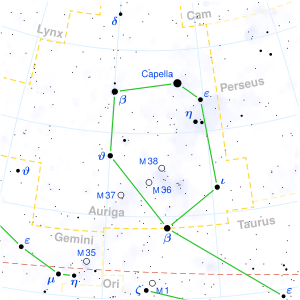UU Aurigae
UU Aurigae is a carbon star and binary star in the constellation Auriga. It is approximately 341 parsecs (1,110 ly) from Earth.
 | |
| Observation data Epoch J2000 Equinox J2000 | |
|---|---|
| Constellation | Auriga |
| Right ascension | 06h 36m 32.83736s[1] |
| Declination | +38° 26′ 43.8139″[1] |
| Apparent magnitude (V) | 4.9 - 7.0[2] |
| Characteristics | |
| Spectral type | C5,3-C7,4(N3)[2] |
| B−V color index | 2.61 |
| R−I color index | 1.43 |
| Variable type | SRb[2] |
| Astrometry | |
| Radial velocity (Rv) | 13.40[3] km/s |
| Proper motion (μ) | RA: -0.50[1] mas/yr Dec.: -19.90[1] mas/yr |
| Parallax (π) | 0.38 ± 0.41[1] mas |
| Distance | 341[4] pc |
| Absolute magnitude (MV) | -3.65[5] |
| Orbit | |
| Semi-major axis (a) | 17.9″ |
| Inclination (i) | 222° |
| Details | |
| Radius | 370[6] R☉ |
| Luminosity | 16,443[7] L☉ |
| Temperature | 2,760[7] K |
| Other designations | |
| Database references | |
| SIMBAD | data |
Description

UU Aurigae is a carbon-rich asymptotic giant branch star. The spectral type listed in the General Catalogue of Variable Stars (GCVS) is C5,3-C7,4(N3). The N3 refers back to an older type of classification where carbon stars were given spectral types of N or R, although the numeric index was correlated more with the strength of the carbon chemistry rather than temperature. The C5 to C7 indicates various classifications using the newer Morgan-Keenan system where the numeric index corresponds better to the temperature of the star. C5 - C7 types are approximately equivalent to early-M stars. The second numeric index, 3 or 4 for UU Aurigae indicates the strength of the Swan bands in the spectrum, on a scale of 1 to 5.[9] Using the more modern revised Morgan-Keenan scheme, a spectral type of C-N5- C2 6- has been published, with the C-N5 indicating an N-type carbon star with a temperature index of 5-, and a Swan band strength of 6- on a scale of 1 to 8.[10]
UU Aurigae is classified as a semiregular variable of type SRb, indicating it is a giant star with poorly-defined variations. Its brightness varies from magnitude +4.9 to +7.0 in visual apparent magnitude.[2] The period is given in the GCVS as 441 days, but there is also a strong variation with a period of 235 days.[11] Using British Astronomical Association observations from 1971 to 1998, the periods are calculated as 439.4 and 233.1 days.[12]
The angular diameter of UU Aurigae has been measured at 12.07 ± 0.22 mas using very-long-baseline interferometry (VLBI).[13] Around the star is a shell of dust made up largely of amorphous carbon and silicon carbide (SiC), with the SiC appearing at three times the star's radius and the amorphous carbon at nine times its radius. Further out is a carbon-rich shell at 300 stellar radii and two oxygen-rich shells even further away.[14] UU Aurigae also has a bow shock 0.14 parsecs wide, created by its motion through the interstellar medium.[4]
References
- van Leeuwen, F. (2007). "Validation of the new Hipparcos reduction". Astronomy and Astrophysics. 474 (2): 653–664. arXiv:0708.1752. Bibcode:2007A&A...474..653V. doi:10.1051/0004-6361:20078357.Vizier catalog entry
- Samus, N. N.; Durlevich, O. V.; et al. (2009). "VizieR Online Data Catalog: General Catalogue of Variable Stars (Samus+ 2007-2013)". VizieR On-line Data Catalog: B/gcvs. Originally Published in: 2009yCat....102025S. 1. Bibcode:2009yCat....102025S.
- Gontcharov, G. A (2006). "Pulkovo Compilation of Radial Velocities for 35 495 Hipparcos stars in a common system". Astronomy Letters. 32 (11): 759. arXiv:1606.08053. Bibcode:2006AstL...32..759G. doi:10.1134/S1063773706110065.
- Cox, N. L. J; Kerschbaum, F; Van Marle, A.-J; Decin, L; Ladjal, D; Mayer, A; Groenewegen, M. A. T; Van Eck, S; Royer, P; Ottensamer, R; Ueta, T; Jorissen, A; Mecina, M; Meliani, Z; Luntzer, A; Blommaert, J. A. D. L; Posch, Th; Vandenbussche, B; Waelkens, C (2012). "A far-infrared survey of bow shocks and detached shells around AGB stars and red supergiants". Astronomy & Astrophysics. 537: A35. arXiv:1110.5486. Bibcode:2012A&A...537A..35C. doi:10.1051/0004-6361/201117910.
- Alksnis, A; Balklavs, A; Dzervitis, U; Eglitis, I (1998). "Absolute magnitudes of carbon stars from HIPPARCOS parallaxes". Astronomy and Astrophysics. 338: 209. Bibcode:1998A&A...338..209A.
- Luttermoser, Donald G.; Brown, Alexander (1992). "A VLA 3.6 centimeter survey of N-type carbon stars". Astrophysical Journal. 384: 634. Bibcode:1992ApJ...384..634L. doi:10.1086/170905.
- Bergeat, J; Knapik, A; Rutily, B (2002). "Carbon-rich giants in the HR diagram and their luminosity function". Astronomy and Astrophysics. 390 (3): 967. Bibcode:2002A&A...390..967B. doi:10.1051/0004-6361:20020525.
- "V* UU Aur". SIMBAD. Centre de données astronomiques de Strasbourg. Retrieved 6 February 2018.
- Keenan, P. C. (1993). "Revised MK Spectral Classification of the Red Carbon Stars". Publications of the Astronomical Society of the Pacific. 105: 905. Bibcode:1993PASP..105..905K. doi:10.1086/133252.
- Barnbaum, Cecilia; Stone, Remington P. S; Keenan, Philip C (1996). "A Moderate-Resolution Spectral Atlas of Carbon Stars: R, J, N, CH, and Barium Stars". Astrophysical Journal Supplement. 105: 419. Bibcode:1996ApJS..105..419B. doi:10.1086/192323.
- Kiss, L. L; Szatmáry, K; Cadmus, R. R; Mattei, J. A (1999). "Multiperiodicity in semiregular variables. I. General properties". Astronomy and Astrophysics. 346: 542. arXiv:astro-ph/9904128. Bibcode:1999A&A...346..542K.
- Howarth, J. J (2001). "The semiregular variable UU Aurigae ( analysis in adversity?". Journal of the British Astronomical Association. 111: 150. Bibcode:2001JBAA..111..150H.
- Quirrenbach, A; Mozurkewich, D; Hummel, C. A; Buscher, D. F; Armstrong, J. T (1994). "Angular diameters of the carbon stars UU Aurigae, Y Canum Venaticorum, and TX PISCIUM from optical long-baseline interferometry". Astronomy and Astrophysics. 285: 541. Bibcode:1994A&A...285..541Q.
- Bagnulo, S; Skinner, C. J; Doyle, J. G; Camphens, M (1997). "Carbon stars with detached dust shells: The circumstellar envelope of UU Aurigae". Astronomy and Astrophysics. 321: 605. Bibcode:1997A&A...321..605B.